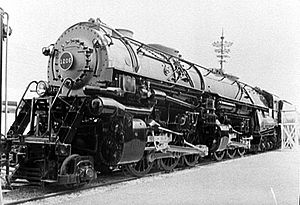- 2-6-6-4
-
In the Whyte notation for the classification of steam locomotive wheel arrangement, a 2-6-6-4 is a locomotive with a two-wheel leading truck, two sets of six driving wheels, and a four-wheel trailing truck. All 2-6-6-4s have been articulated locomotives, of the Mallet or related simple articulated type.
Other equivalent classifications are:
- UIC classification: (1'C)C2' (also known as German classification and Italian classification)
- French classification: 130+032
- Turkish classification: 34+35
- Swiss classification: 3/4+3/5
The UIC classification is refined to (1'C)C2' for Mallet locomotives.
The 2-6-6-4 was a fairly late development, a product of the superpower steam concept, introduced by the Lima Locomotive Works, which encouraged the use of large fireboxes supported by four-wheel trailing trucks. Such a firebox could sustain a rate of steam generation to meet any demands of the locomotive's cylinders, even at high speed. High speeds were certainly among the design goals for a 2-6-6-4; most of the type were intended for use on fast freight trains.
The first 2-6-6-4s built in the United States were for the Pittsburgh & West Virginia Railroad, and these were not high speed locomotives but rather heavy mountain luggers. They received three in 1934 and four more in 1937.
The next of the type were a successful class of ten ordered by the Seaboard Air Line in 1935 and 1937. These were high speed freight engines and were very successful. Upon dieselisation, the road sold the locomotives to the Baltimore & Ohio Railroad in 1947, who operated them until 1953.
The final class of 2-6-6-4s was the Norfolk & Western Railway's Class A, built starting in 1936. 43 were built until 1950. They were the largest until the 4-8-8-4 Union Pacific Big Boy was produced. The powerful 2-6-6-4s were capable of 6,300 drawbar horsepower (4.7 MW) at 45 mph (72 km/h) and able to run at over 70 mph (110 km/h), but were also capable of lugging heavy unit coal trains. They were used until dieselisation in 1959. One locomotive, Norfolk & Western 1218, was preserved and in 1987 was restored to running order, running on frequent excursions until 1991. Today it is on display at the Virginia Museum of Transportation.
In all, 60 2-6-6-4s were constructed in North America.
References
- Trains.com article on the 2-6-6-4 type.
- Jeffries, Lewis I., N&W: Giant of Steam (Rev. ed. 2005).
- Wrinn, Jim, Steam's Camelot: Southern and Norfolk Southern Excursions in Color (2000).
External links
- picture of N&W 1218 pulling an excursion train in 1988
- side view of N&W 1218 under steam in 1987
- builder's photo of N&W 1212, engineer's side, Virginia Tech collection
- builder's photo of N&W 1212, fireman's side, Virginia Tech collection
Steam locomotive wheel arrangements Single engine types 0-2-2 • 0-2-4 • 2-2-0 • 2-2-2 • 2-2-4 • 4-2-0 • 4-2-2 • 4-2-4 • 6-2-0
0-3-0
0-4-0 • 0-4-2 • 0-4-4 • 2-4-0 • 2-4-2 • 2-4-4 • 2-4-6 • 4-4-0 • 4-4-2 • 4-4-4 • 4-4-6
0-6-0 • 0-6-2 • 0-6-4 • 2-6-0 • 2-6-2 • 2-6-4 • 2-6-6 • 4-6-0 • 4-6-2 • 4-6-4
0-8-0 • 0-8-2 • 0-8-4 • 2-8-0 • 2-8-2 • 2-8-4 • 2-8-6 • 4-8-0 • 4-8-2 • 4-8-4 • 4-8-6 • 6-8-6
0-10-0 • 0-10-2 • 2-10-0 • 2-10-2 • 2-10-4 • 4-10-0 • 4-10-2
0-12-0 • 2-12-0 • 2-12-2 • 2-12-4 • 4-12-2 •
4-14-4Divided drive and
Duplex engine typesArticulated locomotives
Garratt and Meyer types0-4-0+0-4-0 • 2-4-0+0-4-2 • 2-4-2+2-4-2 • 4-4-2+2-4-4
0-6-0+0-6-0 • 0-6-2+2-6-0 • 2-6-0+0-6-2 • 2-6-2+2-6-2 • 4-6-0+0-6-4 • 4-6-2+2-6-4 • 4-6-4+4-6-4
2-8-0+0-8-2 • 2-8-2+2-8-2 • 4-8-0+0-8-4 • 4-8-2+2-8-4 • 4-8-4+4-8-4Articulated locomotives
Fairlie and Mallet types
(includes Triplex types).Articulated locomotives
Engerth typesCategories:- 2-6-6-4 locomotives
- Locomotives by wheel arrangement
Wikimedia Foundation. 2010.

